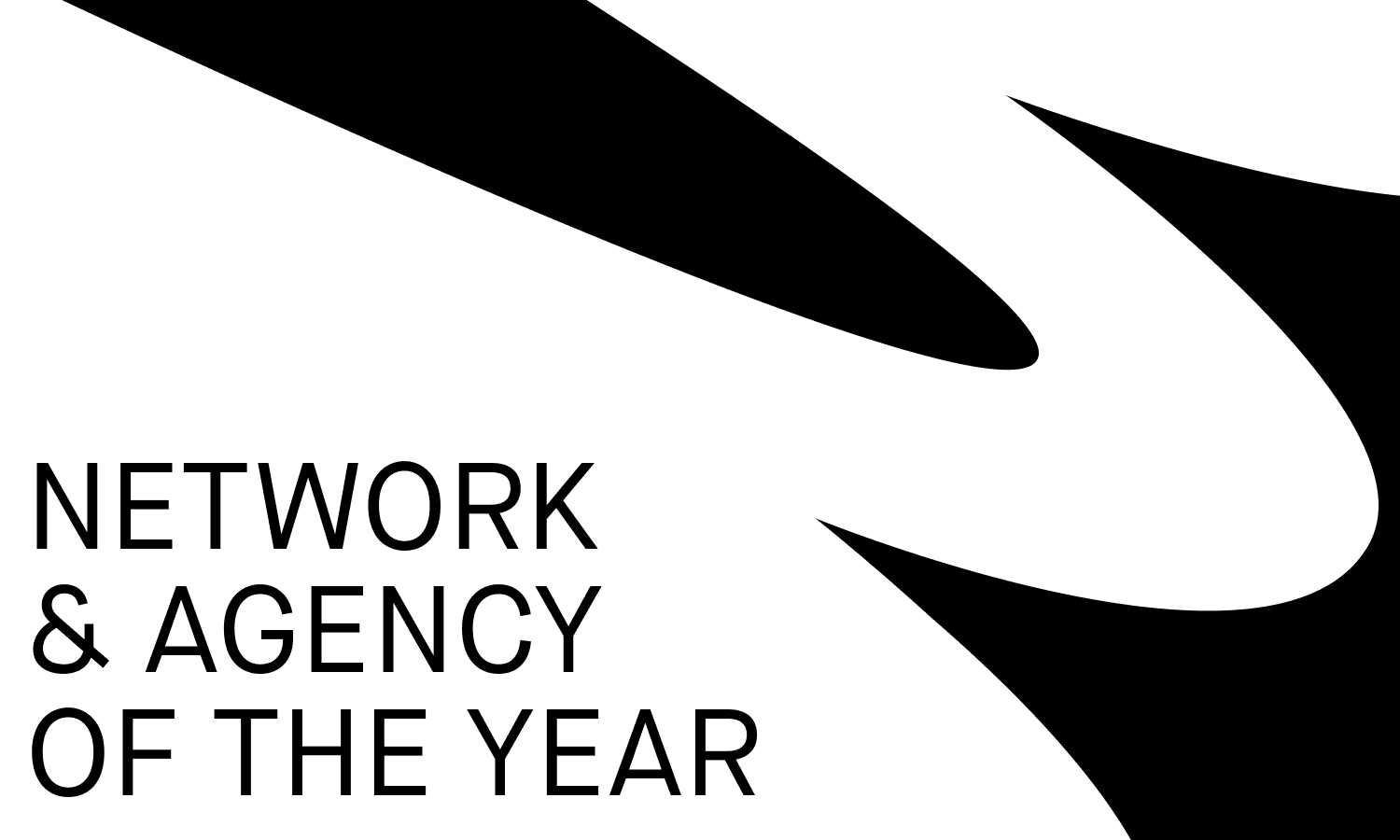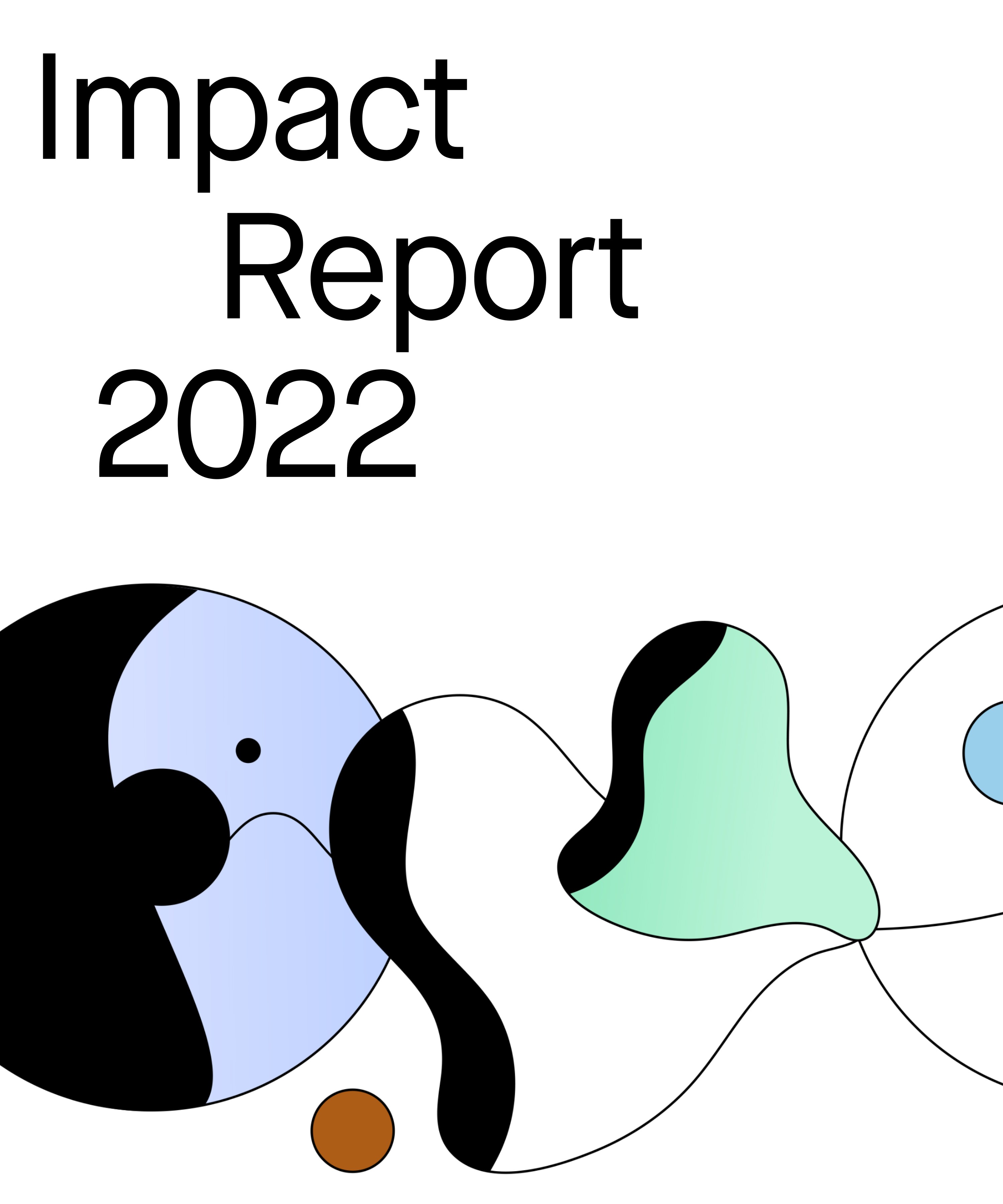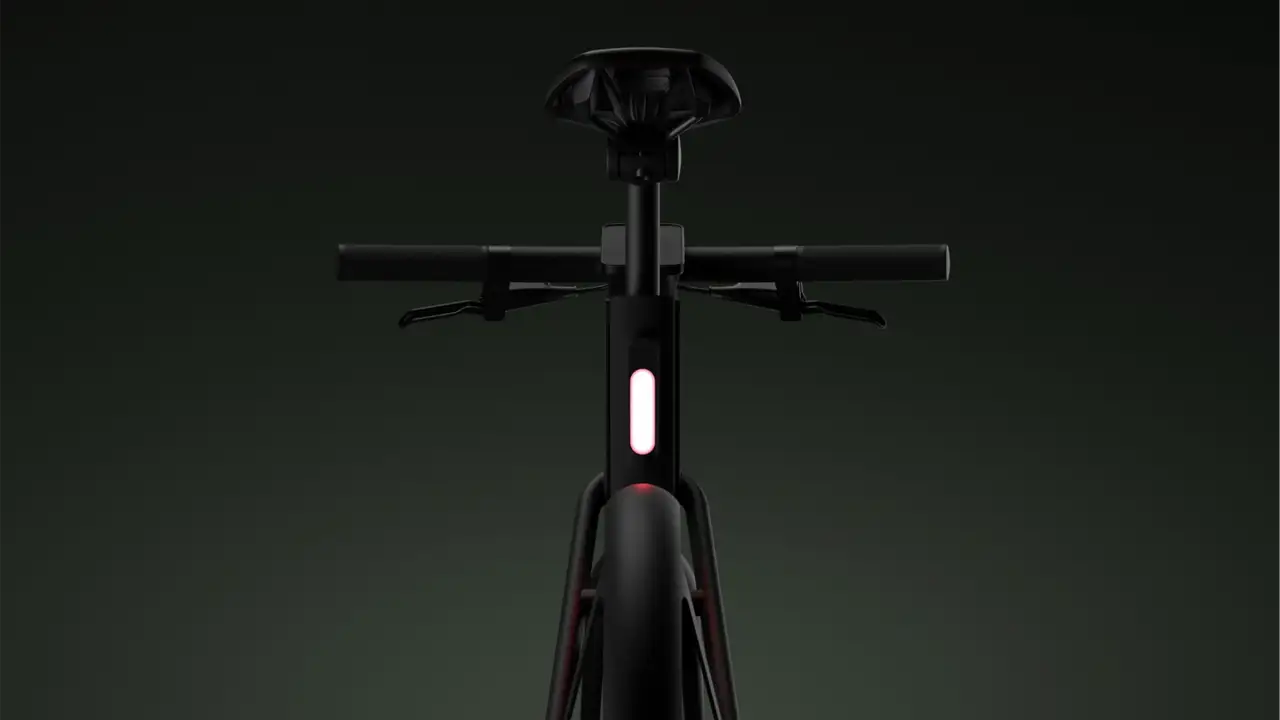
HDFC Ltd. has provided mortgage services in India for 45 years, with a high satisfaction rate among its customers.
Appreciating what home buying means for its customers, the brand wanted to make the borrowing process seamless. So they turned to DEPT® to transform their digital experience ecosystem.
Enhancing digital experience
HDFC Ltd. aimed to deliver higher performance, greater scalability, and more efficient marketing workflows. They also wanted to establish a consistent customer experience across all channels, from the website to the mobile app.
The transition to the new platform was challenging, as the company needed to migrate everything without disrupting current business operations.
In just three months, we deployed a new digital experience ecosystem in seven languages through our Adobe Experience Manager managed services.
Leveraging AEM for seamless migration and enhanced efficiency
First, we performed a necessary site migration to a new CMS. The pre-built core components of Adobe Experience Manager (AEM) helped to speed up website development, reduce costs, and accelerate deployment. Extensive customization options allowed us to meet unique internal requirements and seamlessly integrate website components.
Next, we created a headless architecture for the new environment, which made it easier to optimise content management across channels. This helped the company quickly provide up-to-date and consistent information to home loan applicants.
We also reduced the time of tracking interest rate changes. What used to take up to six hours of a single person’s working day can now be easily accomplished in less than 30 minutes. AEM automation has simplified many other day-to-day processes as well, allowing the team to deliver timely marketing information much faster.
Simplified compliance and lead management
By using Content Snippets, we made it easy to publish disclaimers and other regulatory information that must appear on different pages of loan products. The combined capabilities for creating and automatically publishing from a single console ensured accuracy and compliance with regulatory requirements.
Dynamic real-time creation of forms provided flexibility in the lead generation approach. And a professionally organized AWS database setup using Lambda secured efficient storage and retrieval of lead data.
This made it easy to meet the changing demands of a large enterprise and established a consistent, high-performance experience across various devices and platforms.
Boosting website performance
During the website optimization phase, we implemented sophisticated performance optimization strategies which improved the speed and operational efficiency of the website and helped us meet the needs of HDFC Ltd’s global audience.
We customized SEO changes to accelerate time to market while maintaining flexibility. The changes quickly began to have a positive impact on website traffic and performance.
Outcomes
The HDFC Ltd. expected the site’s performance to improve by about 60% and was pleasantly surprised that the new, faster page load times exceeded those expectations. The site’s performance improved by 75%, which goes a long way in ensuring a positive customer experience.
+75%
in site performance
+11%
in SEO performance
12X
reduction in time tracking interest rates
Questions?
VP Global Adobe Alliances
Himanshu Mody
For the second year running, DEPT® is celebrating being named Network of the Year at The Webby Awards, with BASIC/DEPT® also winning Agency of the Year.
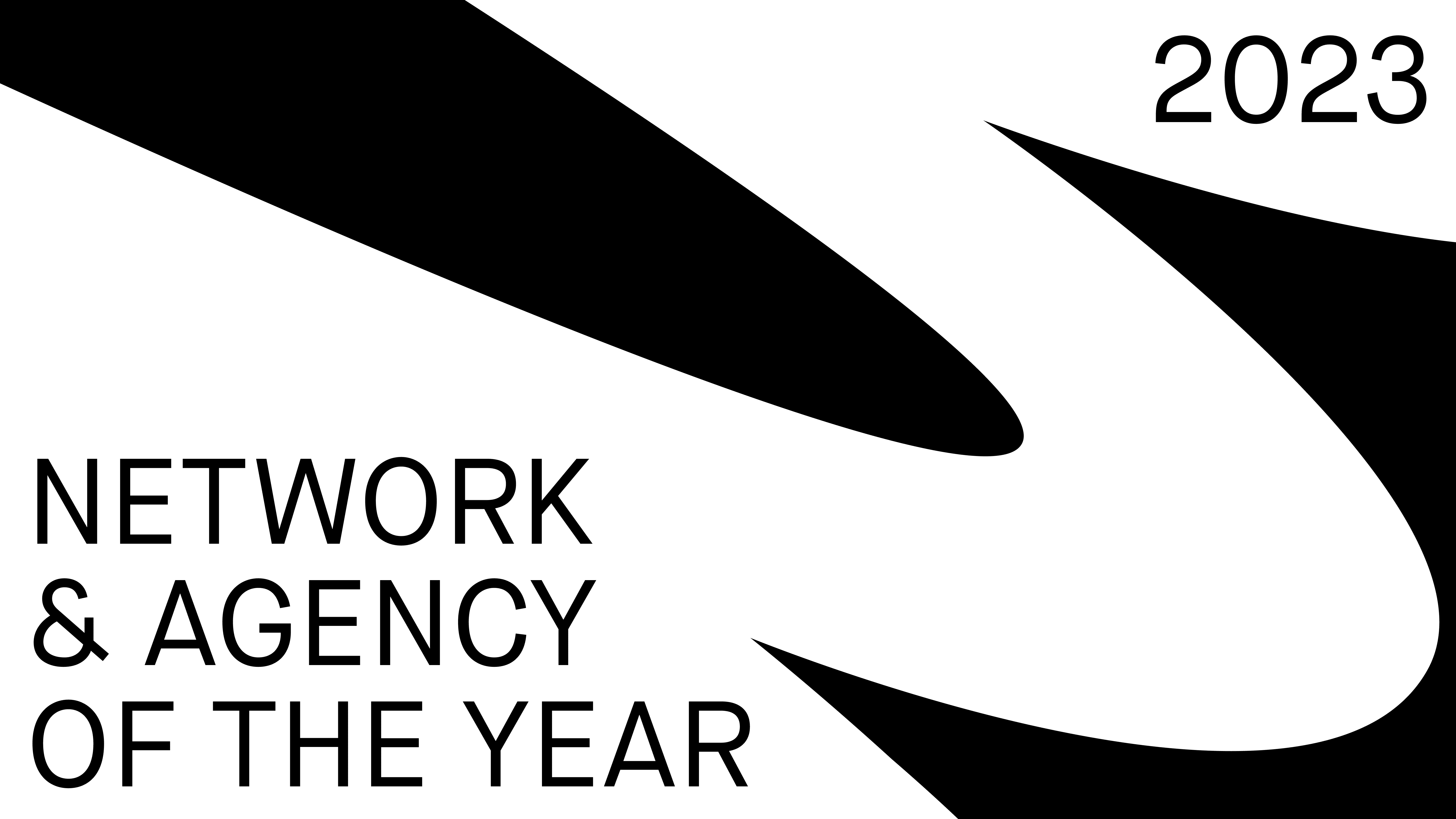
Webby Winners
The Webby Awards is the internet’s most respected symbol of success, attracting over 14,000 entries from 70 countries worldwide every year. It’s been a stellar year of wins for DEPT®, with 6 Webby Awards, 27 People’s Voice Awards, 32 nominations and 20 honorees, for our work with brands including Patagonia, Google, Cowboy, H&M, and KFC.
DEPT®’s work for HYPEWEAR by ABOUT YOU, the first online shop for digital NFT fashion, won both the Webby Award and People’s Voice award for App Features: Best Use of Web3 Technology.
BASIC/DEPT® won both the Webby Award and People’s Voice awards for Google Store in the Websites and Mobile Sites, Best Mobile User Experience category, Google ChromeOS in Websites and Mobile Sites, Best Mobile Visual Design – Function, Patagonia in Websites and Mobile Sites, Best Practices, and The Patagonia Footprint Chronicles site in Websites and Mobile Sites: Corporate Social Responsibility.
The immersive website experience for Virgin Galactic by HELLO MONDAY/DEPT® that communicates the excitement of space travel, won both the Webby Award and People’s Voice awards in General Websites and Mobile Sites – Travel & Lifestyle.
We’re super thankful to our awesome clients and our talented teams whose pioneering work sets the standard in technology and marketing,” said Dimi Albers, CEO of DEPT®. “To be named global network of the year for the second year running and for our BASIC/DEPT® team to win agency of the year is an awesome achievement; we’re humbled and grateful to everyone who voted for us. In our five word speech last year we said ‘we’re just getting started,’ I guess these wins show that we really meant that. :)”
People’s Voice Winners
The public voting declared these following projects by DEPT®, BASIC/DEPT®, HELLO MONDAY/DEPT®, DOGSTUDIO/DEPT® and STUDIO DUMBAR/DEPT® the winners of the People’s Voice awards:
- The unique Web3 experience we created for fashion brand H&Mbeyond, which turned their showroom into an immersive, virtual experience, won for Metaverse, Immersive & Virtual – General Virtual Experiences: Arts, Fashion, Retail & Culture.
- BASIC/DEPT®’s website created for Cowboy, the connected electric bike, won four awards for Best Visual Design: Function, Best User Interface, Best Mobile Visual Design: Aesthetic, and Best Mobile User Interface.
- The website for the first NFT project by artist Jeff Koons won Websites and Mobile Sites – Features & Design: Best Homepage.
- The project for Google ChromeOS won General Websites and Mobile Sites: Web Services & Applications, and the work for Google Store won Best User Experience: Websites and Mobile Sites
- Crafted, the community initiative led by BASIC/DEPT® that brings together local creators and tastemakers, won General Websites and Mobile Sites: Diversity, Equity & Inclusion.
- JAMS – BASIC/DEPT®’s social experiment that connects people with curated playlists won Websites and Mobile Sites – Features & Design: Technical Achievement.
- The Patagonia Footprints Chronicles site won General Websites and Mobile Sites: Sustainability & Environment.
- The app for KFC won General Apps: Food & Drink.
- Webex won Websites and Mobile Sites: Best Navigation/Structure.
- For HELLO MONDAY/DEPT®, Fingerspelling with Machine Learning won three awards in the Games category for Family, Kids & Education, and Social Impact, and in the Responsible Technology category for Accessible Technology.
- The site built to build anticipation for Digital Insight Games’ launch of Cloud Castles won two awards for Websites and Mobile Sites – Features & Design: Technical Achievement, and General Metaverse Experiences: Games.
- Demo Festival – the world’s largest festival of motion design – organized by STUDIO DUMBAR/DEPT® won General Websites and Mobile Sites: Events.
- DEPT®’s very own Meta Festival – the first 24hr event in the Metaverse – won Metaverse & Immersive Features: Best Community Engagement, and Metaverse, Immersive & Virtual – Virtual Video Features: Best Festival or Conference.
Honorees
In addition to the award wins, 20 projects for the following clients were shortlisted or awarded as Honorees: Inter Milan; Lululemon Studio; Design Within Reach; Google Store; Jeff Koons; KFC; VIZIO; eBay; Adobe; HAPE; Meebits; Panasonic; Sprite; DIG: Cloud Castles.
Congratulations to our talented teams, and a huge thank you to our awesome clients who entrust us to pioneer their marketing and technology.
More news
Questions?
Global SVP of Marketing
Marjan Straathof
Sustainability is no longer a buzzword, but a critical business strategy for 2023 and beyond.
Globally, 95% of consumers consider a product’s sustainability to be important and 88% shared their intentional support for a brand that supports social or environmental initiatives.
But as climate change becomes increasingly dire, brands—together with the larger world—have also become aware of the environmental costs of technology and digital marketing. As much as 32% of an individual’s carbon footprint comes from advertising. And with $500 billion spent by marketers on advertising every year, you can understand how significant the industry’s impact on climate change is.
With that in mind, as both a digital agency and a certified B Corporation, we’d like to share some strategies for green-ifying your digital business and marketing efforts.

Create campaigns with a net zero footprint
Advertising-related emissions aren’t just already responsible for a significant portion of global emissions, they’re increasing as well. Between 2019 and 2022, emissions from advertising campaigns increased by 11%.
If you’re looking for a way to bolster a reduction strategy or to kickstart a sustainability initiative, marketing and advertising campaigns are a logical place to start.
One means of mitigating the impact of marketing campaigns is by offsetting them using a trusted provider to purchase carbon credits. We work with ClimatePartner, which helps us measure the impact of a campaign and source a sufficient amount of carbon credits to compensate for it.
By working with vendors like ClimatePartner, you can also walk through a few potential strategies for your campaign to determine what channels you can utilise that strike a balance between audience impact and carbon impact.
Build greener solutions
Tech is changing in more ways than one. Not only are innovations like Web3 emerging, so are ways of improving tech’s sustainability.
When it comes to cloud environments and cloud-based architecture solutions, providers like Microsoft offer options that can vastly reduce your carbon footprint. Compared to old-school on-premises data centres, Microsoft Azure is as much as 98% more carbon efficient.
Within the past several years, other cloud providers have also taken steps to increase their efficiency and reduce their environmental impact. To get a feel for how effective (or ineffective) these providers have become, it helps to use a metric called “power usage effectiveness,” or “PUE.”
PUE is expressed as a ratio, with efficiency increasing as the quotient decreases toward a value of 1.0. The average PUE for an on-prem data centre is 1.70, by contrast, Microsoft Azure has a PUE of 1.18.
Given these recent developments in sustainability, we’re now helping clients re-assess their architecture and build a solution that keeps sustainability top of mind.
By using a cloud environment based in Microsoft Azure, AWS, and/or Google Cloud, you’re not only able to build a greener architecture, but you can also automate key processes to eliminate overconsumption of cloud resources and better your system’s PUE.
Manage your carbon impact with Net Zero Cloud
Salesforce’s Net Zero Cloud was launched last year to allow companies to report on their carbon emissions.
Net Zero Cloud is an easy-to-use system within Salesforce that uses a set of predefined emissions factors for measuring the carbon emissions associated with everything from the impact of your tech stack to energy consumption within offices to commuting and travel. In turn, it calculates the number of carbon credits you’ll need to purchase to offset your brand’s footprint.
Overall, the system does more than help you to measure and offset your brand’s carbon footprint: it also helps improve transparency with stakeholders at your brand and allows you to strategise your emissions reduction by testing various scenarios.
Having already implemented Net Zero Cloud for ourselves to help us stay on top of our sustainability goals, DEPT® has also become a Net Zero Cloud partner to help our clients do the same.
Encourage thinking about carbon
Thinking about sustainability can feel overwhelming at times. Let’s face it: every day the work we do in our industry inevitably puts more carbon into our atmosphere.
That said, by encouraging folks within your team and at your company to start thinking about carbon more often, you’ll find that many small-scale changes add up.
For instance, the video and content production team at DEPT® has started encouraging clients to donate £250 per shoot to offset the carbon emissions associated with the project.
Although the team isn’t able to measure the exact emissions associated with a given shoot, their mission to do good has made a difference. In total, they’ve helped raise nearly £12,000 for the Woodland Trust, a British reforestation project that plants native trees throughout the country.
By learning to think about your emissions output, you and your team will start to learn how to weigh your options and make choices or create new practices that help the planet.
The bigger picture
As consumers demand more from brands, many have taken it upon themselves to commit to achieving net zero carbon emissions on a company-wide scale.
DEPT® achieved our own net-zero goal following our Climate Neutral Certification in 2021. As part of this certification, we’re required to measure our company-wide carbon footprint every year and offset it using carbon credits.
That said, should you choose to pursue your own large-scale net-zero goal, it’s important to remember that carbon credits are just a piece of the puzzle. They don’t erase your impact, rather, they’re a way of taking responsibility for them while you actively work on reducing emissions with strategies like those we’ve outlined here.
If you’re interested in partnering with an organisation to help your brand go net zero, we highly recommend Climate Neutral for their support in creating and holding us accountable in hitting our reduction strategy targets.
Interested in learning more about purpose and sustainability in 2023?
Download the DEPT® 2023 Trends Report.
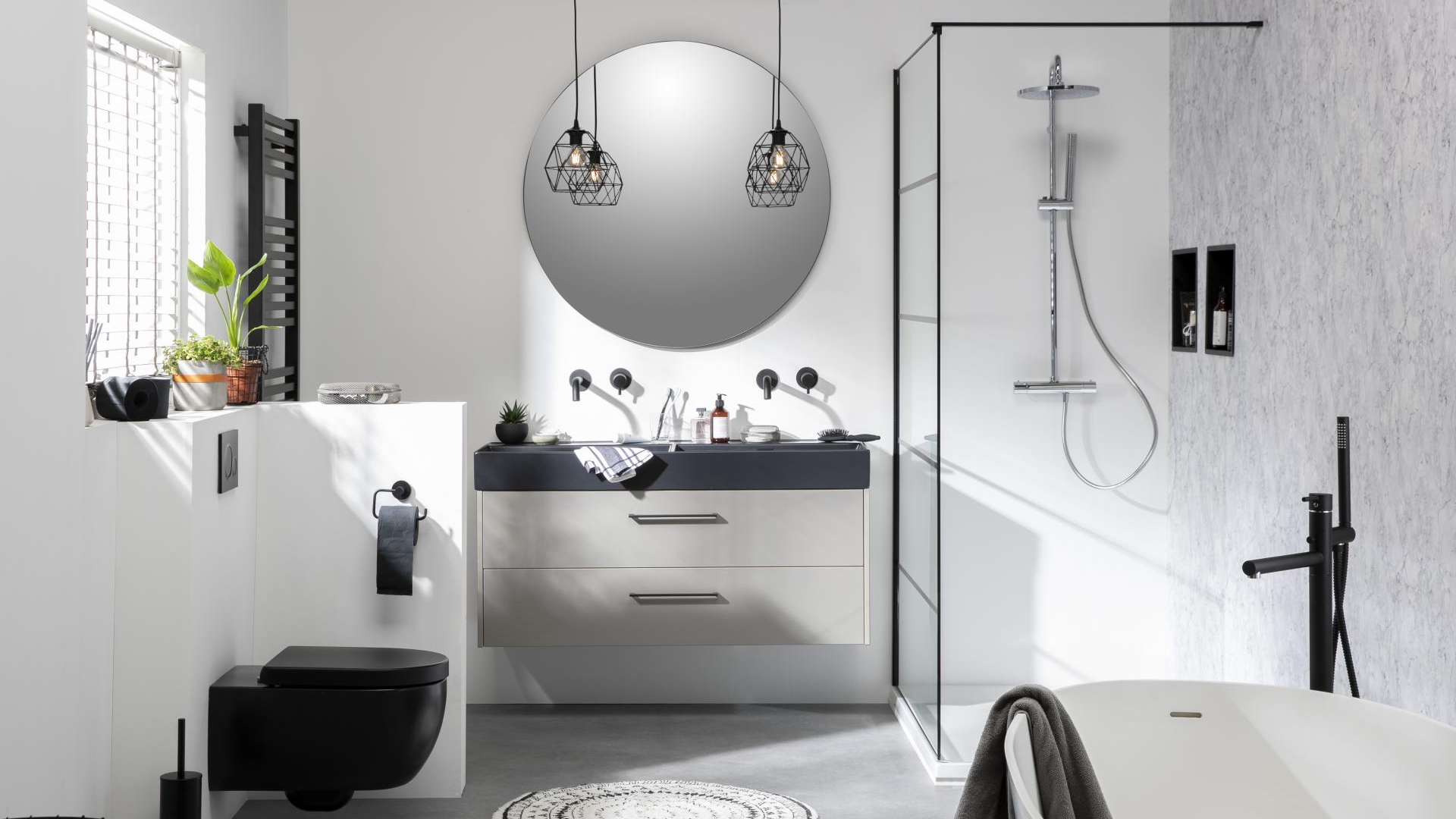
A good house isn’t complete without good plumbing. In terms of product range, expertise and service, the Plieger Group is a leader in their industry. However, when it comes to digital maturity, they realized they still had plenty of steps to take.
To establish themselves as a digital standout in their industry, Plieger collaborated with DEPT® on a brand refresh, a brand new native app and a web shop for both Plieger and ThermoNoord.
In 2021, we will further focus on data-driven optimization of the various channels, performance marketing and potentially moving up the value chain.
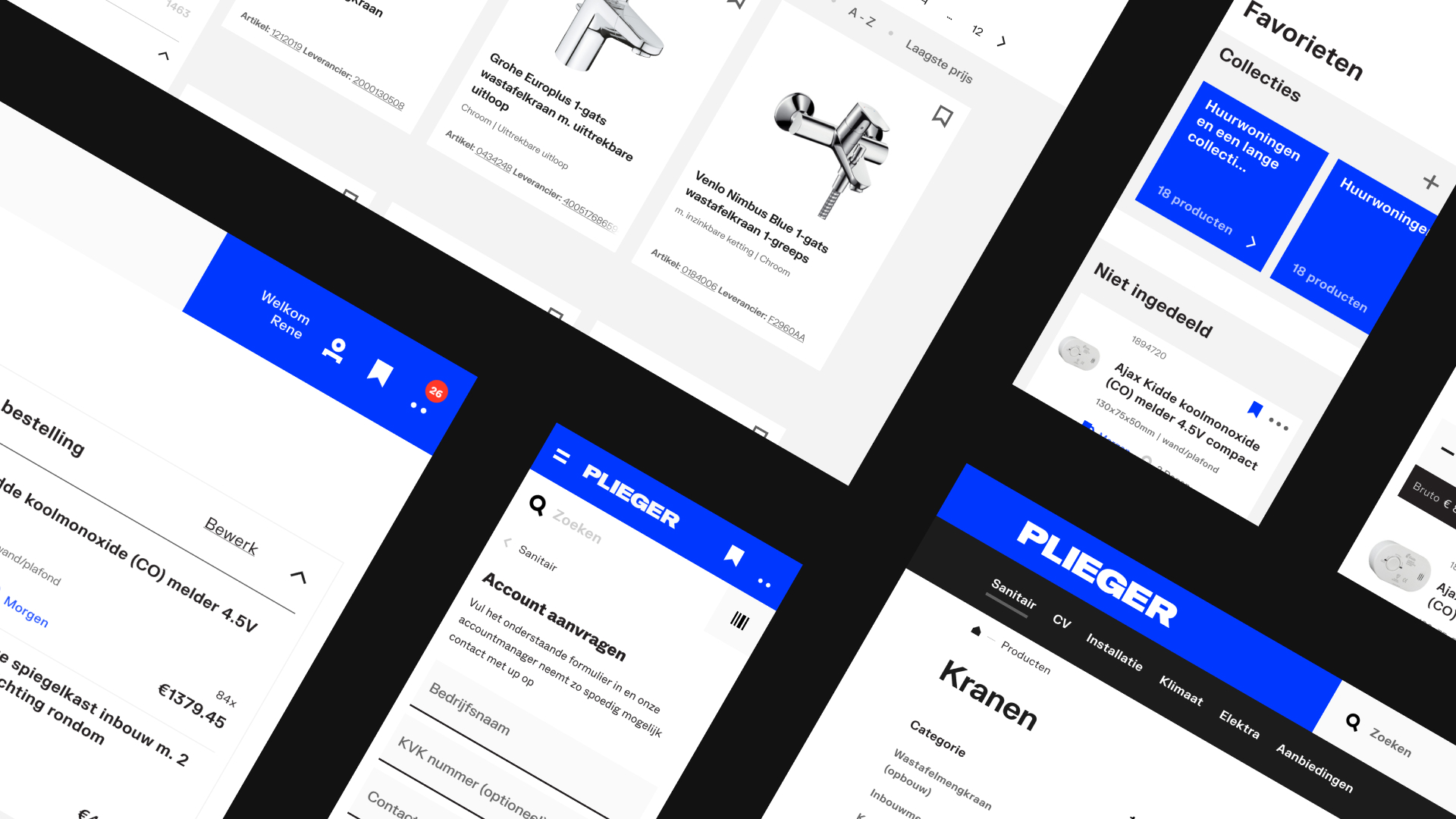
Sanitary expert
In the Netherlands, Plieger Group supplies a range of more than 150,000 items to installers, plumbing companies, retailers and hardware stores, among others. Their sub-brand, ThermoNoord, focuses mainly on ventilation.
For this project, Plieger Group’s main goal was to revamp its digital presence with a full-fledged webshop.
“Our webshop was outdated, did not provide live stock information, did not work well on mobile or tablet and was not future-proof,” said Jeroen Heydendael, Manager of Marketing & eCommerce at Plieger, “It was high time for a change!”

Exploring

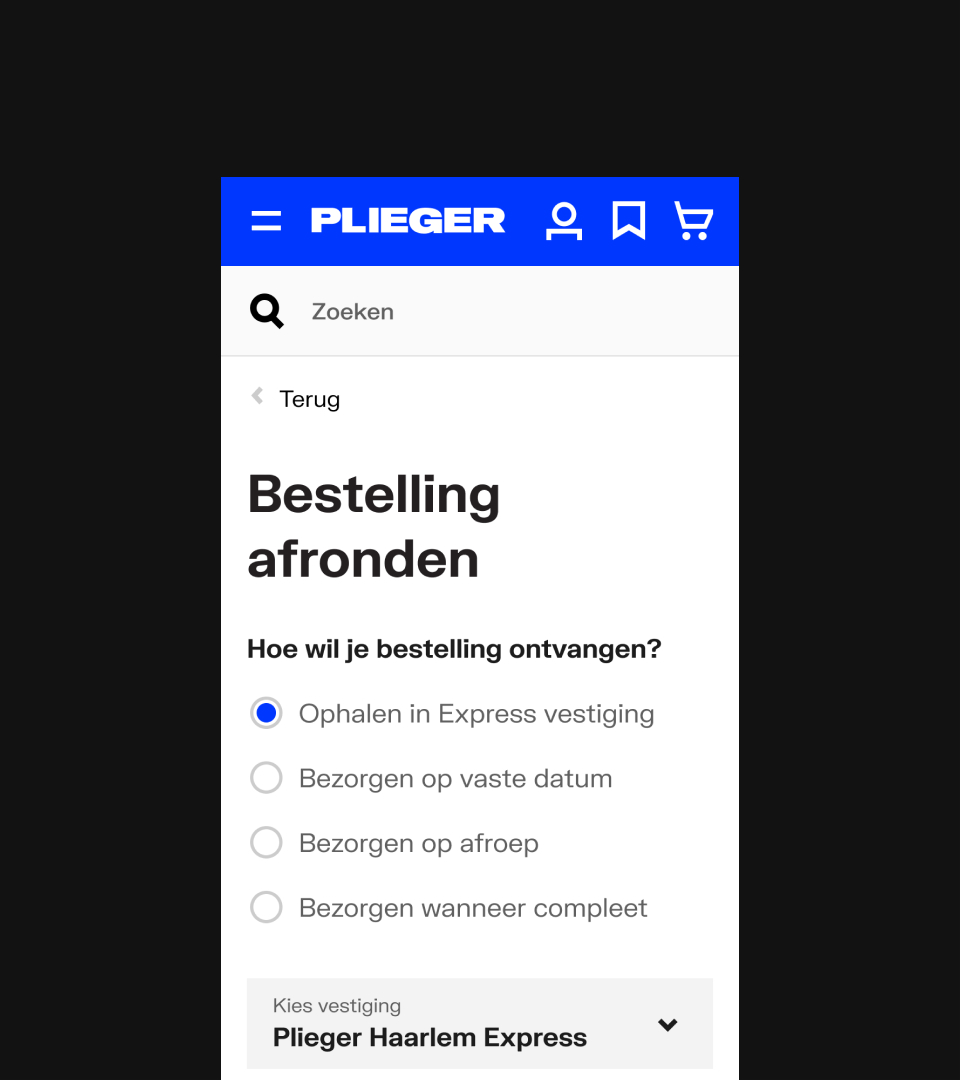
The Native app
By using React Native and Expo, we built a native iOS and an Android app for both Plieger and Thermonoord simultaneously using the same code base. This code base was directly linked to SAP as the ‘single source of truth’ for 4 native apps.
Every version of the app had the same useful features, including the creation of different permissions and payment options for each user profile as well as the ability to have products delivered or picked up.
Because the app also contained a very large product overview—with 12,000 products from as many as 500 brands—we also added a barcode scanner to make it easy to order new products from local retailers.
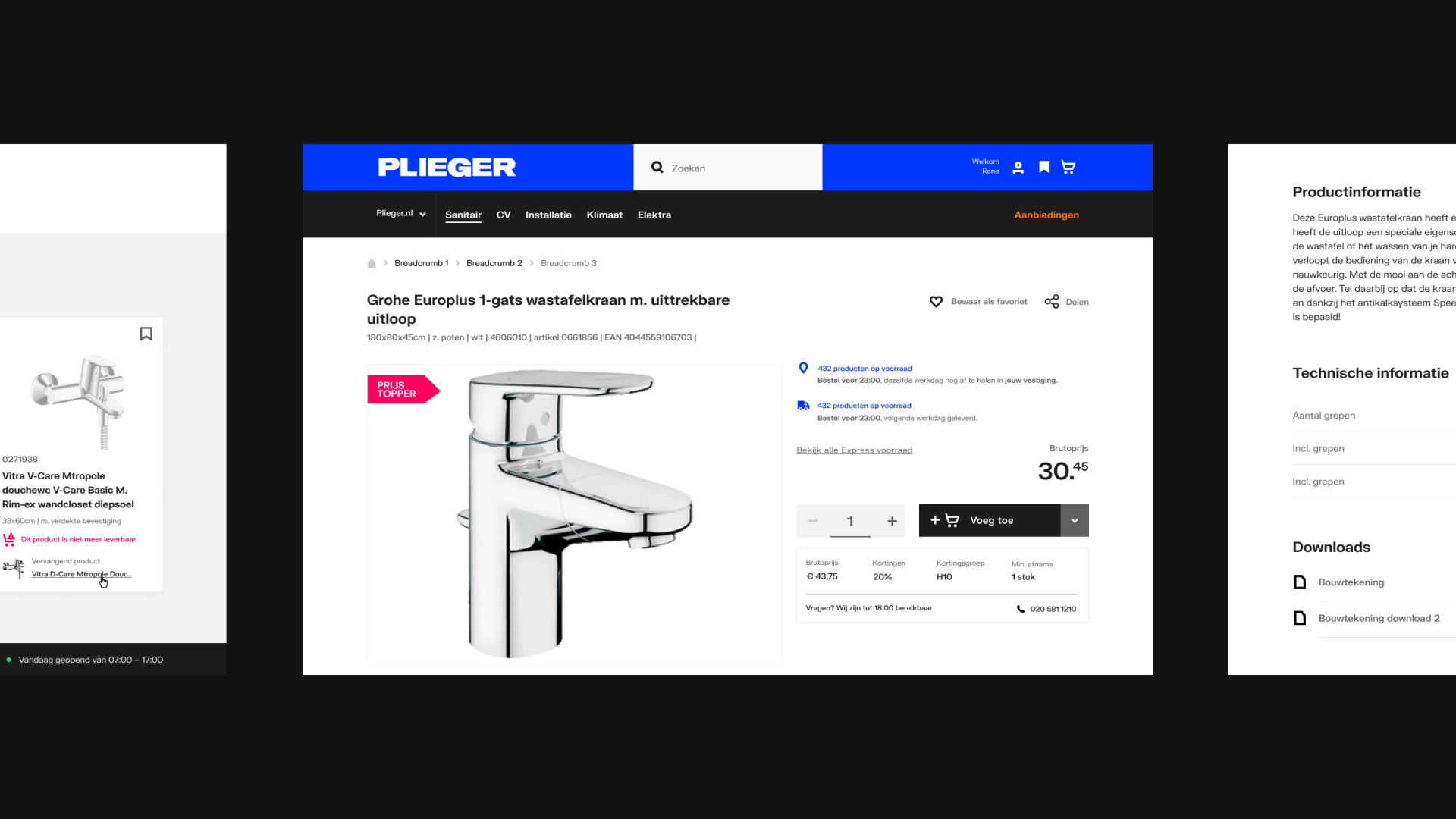
Het platform
We built the platform is built in SAP Commerce Cloud, using Hybris. Hybris allows users to build modular pages through Page Builder functionality. Additionally, we designed and built a separate component system that allows Plieger’s content managers to build their own pages.
The blocks we created gave Plieger the ability to design pages quickly within the brand’s guidelines with options for image placement, titles, rich text, colors, and alignment.

DEPT® & Plieger
In addition to our work together on the new shop and app, we also supported Plieger in its digital transition.
During our consultations, for example, we ensured the digital organization and processes we were using would align with the needs of various internal departments (such as IT, Finance and logistics). Going forward, the ultimate goal is to continue to develop the commerce team efficiently.
Besides further optimizing the shop and developing service features that “bind” installers to Plieger, this year we are also focusing on enriching product information and offering inspiring content.
“The new shop and app are a great first step in our digital transformation,” said Jeroen Heydendael, Manager of Marketing & eCommerce at Plieger. “We still have a long way to go, but DEPT® helped us very much in terms of UX, creativity and technology. We are moving forward quickly with next steps, such as data-driven services.”
Questions?
Inspired by the opportunity to memorialize life’s most treasured moments, Framebridge provides consumers with bespoke, high-quality, and cost-efficient framing options. The company has grown to offer design services, Gallery Walls, and Quick Ship gifts in addition to its custom framing capabilities. Building on its robust e-commerce business, Framebridge now has nearly 20 physical locations along the east coast of the United States and in Illinois.
Customers choose Framebridge to share their stories through artistic display. Framebridge’s one-of-a-kind frames are handcrafted by experts to the customer’s precise specifications. This attention to detail and personalized care is the hallmark of the Framebridge brand and what drives its persistent growth.


121%
increase in CTR
7%
reduction of CPM
14%
increase in ROAS
Strategically scale growth
The ever-changing digital landscape coupled with supply chain challenges and rising costs created an environment that threatened to limit Framebridge’s scalability during peak seasons. As Framebridge sought expansion into untapped markets for both online and in-store shopping, the company needed to build awareness among new audiences, as well as remain top-of-mind with prospects and repeat customers. A full-funnel approach to marketing would help the company synchronously attract new customers, increase intent, and drive purchases.
The holidays are typically a strong sales season for Framebridge. Between Black Friday, Cyber Monday and Giving Tuesday, there are multiple opportunities to tailor creative and optimize campaigns. DEPT was tasked with developing a winning strategy to ensure fourth quarter 2021 holiday and promotional campaigns would resonate with consumers.
However, the rising cost of digital advertising was a significant concern as more customers shop online. Competition for digital advertising space skyrocketed during the pandemic when much of life shifted online and shows no sign of slowing down. Since the pandemic began in 2020, the cost to advertise on Meta grew substantially. Looking at Q4 of 2021, the cost per click (CPC) and cost per thousand impressions (CPM) were 33% more than just one year prior. For growth, Framebridge sought a more economical way to reach more customers.
To stand out amid perceived barriers and challenges, DEPT® recommended that Framebridge invest into Meta branded content campaigns and shift their advertising focus to creative and creator marketing. By leaning into branded content, Framebrige could leverage assets developed by influencers with a native look and feel in their media mix.
Content creators drive value
A key means for testing creative preferences is influencer partnerships. Influencer marketing, also known as creator marketing, is a core strategy in social media today as consumer behavior continuously evolves. Influencers boost the reach of ads by introducing the content to new, different, and expanded audiences, while also providing more opportunities to frequently optimize these ads.
Meta-branded content leverages a network of media outlets, celebrities, and social media influencers to share sponsored content. Each branded content social post features “sponsored” by the entity’s name to reflect a paid partnership between the content creator and the brand. This strategy enables brands like Framebridge to amplify the most popular content by turning them into branded content ads on Meta.
Branded content ads are an effective strategy for expanding reach, influencing intent, and increasing sales, largely because consumers appreciate recommendations of products and services from people like themselves. Creator content may feel and look more authentic to consumers compared to advertisements from a brand. The creator’s originality can provide a fresh and personable perspective about a brand’s product or service that consumers find more trustworthy and favorable. Meta-branded content ads often feature detailed accounts of the influencer’s experience with a brand’s product or service. This narrative inspires, educates, and provides audiences with a behind-the-scenes look at Framebridge’s framing and hanging process.
We recommended branded content as a solution to also beating increasing digital advertising prices. The value in this approach comes from the endorsement from the influencer. As consumers look for guidance in wading through shopping choices, influencer content stands out and an implied recommendation or stamp of approval from the influencer can convert customers.
Branded content boosts the bottom line
Framebridge’s branded content campaign ads out-performed traditional ads, with an over 121% increase in click through rate (CTR) and a 7% reduction in cost per thousand impressions (CPM). Brands often struggle to scale Meta advertising due to rising upper-funnel costs, but Framebridge saw significant improvements by leaning into branded content with us. Branded content ads drove a 14% higher return on advertising spend (ROAS) than traditional ads in Q4, despite the fact that traditional ads more clearly highlighted promotions and holiday messaging. Additionally, the lower cost of branded content allowed Framebridge to diversify content AND beat out other competitive bids on Meta to accelerate sales growth.
Single image ads drove 35% of overall Framebridge purchases on Meta. The combination of video and single image ads in a carousel display also enabled Framebridge to show before and after creations when framing and displaying art. These ads drove 37% of overall purchases, and 71% of those purchases came from branded content.
Top-performing ads featured Framebridge gallery walls, which showed the influencer’s first-hand experience hanging the frames and a peek at the influencer’s home before and after displaying the gallery wall. These high-performing ads included a Shop Now call to action, making up 90% of all purchases and revenue. The carousel and video ads did not feature bold promotional or seasonal messaging, though delivered a high CTR.
Branded Content Holiday campaigns that ran during Black Friday, Cyber Monday, and Giving Tuesday performed very well without any sale or promotional discount offering. This showed us that consumers had a strong intent to purchase from Framebridge, regardless of a promotion. Through influencer partnerships and customized content, brand exposure drove year-over-year revenue increases of 66% for Framebridge.
Questions?
VP of Growth
Lou Amodeo
Discover more
Forrester recently published its “Now Tech: Global Digital Experience Services, Q4 2021” report to profile 37 digital providers that are helping brands with digital marketing, commerce and customer experience initiatives.
In their report, Forrester analysts Ted Schadler and Frederic Giron define digital providers as “essential partners to building [your brand’s] digital experience.” And digital experience means quite a lot. It embodies the combination of creativity and technology; everything from strategy, to implementation, to marketing, to optimization, and all that’s in between.
From our perspective, the digital experience is just as essential as your brand’s digital provider. Maybe now more than ever. After all, during the first three months of the pandemic, digital advanced the equivalent of ten years. A year and a half later, the world is now more digitally literate than ever before. And it’s only getting more so. To make it in a digital world, businesses must develop digital experiences to both meet the current needs of their customers and to future-proof their brand.
When shopping for the digital provider that will best fit your brand’s digital needs, Forrester breaks their recommendations down according to size. DEPT® is relatively small in this standing, at about 2,500 employees compared to 25,000 at large providers.
That said, what is the benefit of making your essential partner in creating digital experiences a comparatively small provider?
Forrester reports that, unlike the large and mid-sized digital counterparts, “Smaller providers generally don’t have the breadth or scale but may offer specialties that the bigger players don’t provide.”
Other major research firms confirm the value of a specialized digital experience. Mckinsey notes that a highly personalized, individual approach to a customer experience – particularly when a brand’s customer base is in the millions – boosts customer loyalty and gives that brand a competitive edge that is hard to imitate. And Harvard Business Review observes that in a world where digital feels almost ubiquitous, “there is no satisfactory excuse for a poor digital experience.” In short, if a brand does not successfully meet or surpass a customer’s digital expectations, they’re quick to move on. After all, countless other brands are just a quick search away.
We can also confirm the value of the specialized digital experience because we are highly specialized. Because “small” certainly does not mean that pushing out amazing global digital experiences is beyond our capability. Whether it’s the unique AR filter & branded hashtag we created for ASOS that generated over 1.2 billion views in just three weeks, the Lovie-nominated virtual landscape we were tasked with creating for the Eurovision Song Contest, or our work for Philips’s “Right under your nose” campaign to raise awareness of men’s health issues, we believe that specialized digital experiences work really, really well.
More Insights?
View all InsightsQuestions?
Head of Marketing US
Kristin Cronin
For companies big and small, digital transformation is placed firmly on everyone’s agenda this year. With Adobe again being the leader in the Gartner DXP quadrant, and their new proposition Digital Foundation now available, the SMB shortlist for affordable marketing technology vendors just got longer. Digital Foundation bundles Adobe’s high-end solutions to enable SMBs to create personalized digital customer experiences quickly and efficiently as a SAAS solution. In this blog, we’ll take a closer look at Digital Foundation and see how it fits in the overall field of marketing technology.
In response to Covid-19, companies worldwide sped up their adoption of digital technologies considerably. According to a McKinsey study, companies accelerated the digitisation of their customer and supply-chain interactions and of their internal operations by three to four years. Additional research by the SMB group found that the top three priorities for SMBs are adding “no-touch” payments, creating virtual service offering and increasing the use of digital channels. The common denominator? Improving the customer experience.
People buy experiences
Essential for making the shift to digital successfully, is the ability to create relevant and meaningful digital customer experiences. Because in the end, people buy experiences, not products. The impact of experience on business becomes clear when you consider that according to research done by Forrester, experiences lead to 1.6x customer lifetime value and 1.7x customer satisfaction rates.
For larger companies, improving customer experiences has been given top priority for some time now. But for most SMB companies, the unforeseen need for digital transformation came rather unexpectedly due to Covid-19. Especially for those who hadn’t orientated themselves before on marketing technology, digitalization comes with new, big challenges.
SMB challenges to creating digital experiences
Besides the usual budget and time restraints that every organisation has, SMBs face challenges typical for their small size regarding digital marketing. In DEPT®’s daily practice of helping SMBs with creating and improving their digital experiences, we see the following three challenges stand out:
The big choice
CMOs tasked with bringing their digital marketing up to level, find themselves with the key question: best-of-suite or best-of-breed? Often, for SMBs, a suite solution provides a better fit due to organisational restraints and the needed faster time-to-market. Additionally, due to those same demands, SMBs find themselves orientating on cloud solutions that come with much-needed perks: high availability, scalable, always up-to-date and secure. There are many solutions in the category of best-of-suite cloud solutions already that CMOs can choose from. And now, with the arrival of Digital Foundation by Adobe, a new high-end cloud solution becomes available. So what does Adobe has to add to an already crowded market?
Adobe for SMB
Over the last decade, Adobe has developed itself into a leading solution provider covering e-commerce and digital marketing delivered via cloud. If you are looking into one-stop shop solutions for bringing your customer experiences to the next level – highly personalised and seamlessly across all the touchpoints – you have most likely heard of Adobe. It’s placed in the top right corner for leaders in both The Forrester Wave and Gartner’s Magic Quadrant for Digital Experience Platforms.
As a high-end full marketing suite solution with the goal to realise first-class customer experiences, Adobe carries a corresponding price tag that has put Adobe primarily within reach of enterprise businesses. Now, under the brand Digital Foundation, Adobe bundles four of its core products as a SaaS solution specifically for SMB companies for a matching price: Adobe Target, Experience Manager Site CMS, Adobe Analytics and Premier support.
The suite is aimed for companies with between 100 and 1000 employees and a turnover between €50 and €1000 million. By offering Digital Foundation solely via cloud, the performance delivered is secure, resilient and easily scalable. The cloud deployment will also help lower TCO and operating costs, which put SMB in direct league with larger organizations that can readily employ more IT staff.
On the other hand, using Adobe products can be a little tricky for new users given its many features. For a novice user, the configuring part can be challenging, making learning and training a requirement. Getting up to speed may take a long time for non-technical users, so guidance from a specialized Adobe partner such as DEPT® is advisable.
Creating the experiences that customers seek
With the right implementation partner to set up the technology, a typical full go-live is reachable after 4 to 10 weeks, depending on the complexity of the website. Adobe sees clients fully running with analytics and personalization in place within 90 days. This fast get-to-market helps to accelerate the first time to value.
The demands of customers in terms of addressing them on digital channels have increased, says Florian Hermann, Head of Medium-Sized Enterprises, Central Europe at Adobe. “The very first contact a customer has with a company or a brand decides whether it will be possible to make it successful. From the start, the customer experience has to be personal, relevant and consistent. Successful SMBs will only be able to extend their current success in the future if they can create those experiences that their customers seek and expect. That’s why it’s so crucial for SMBs now to advance their digital maturity.”
Digital transformation is booming
The acceleration of digitalization is not expected to slow down. Consumers introduced to the ease of e-commerce and digital interaction with brands are highly likely to keep buying and interacting digitally, as McKinsey reports.
For SMBs, digital transformation is likely to come with a growth in competition. Bringing your business online is not enough for thriving, you’ll need to outrun and outclass your competitors. This is where choosing the right technology to create personalized digital experiences makes the difference. It’s advisable to make a thorough comparison of the available Digital Experience content platforms as an SMB business.
In the coming years, the CMS market is expected to shift considerably. The ability to create and continuously improve those personalized and rich customer experience that customers expect and crave, is what will set leading companies apart. With Adobe becoming accessible for SMBs, you can have access to an industry leader for a competitive price.
More Insights?
View all InsightsQuestions?
VP Global Strategic Alliances at DEPT®
Anthony van de Veen

It can feel impossible to capture the spirit and energy of physical events and translate that into a digital experience. For years, employees have gathered by the water cooler or gone on company outings together. But that is no longer possible. Virtual calls have replaced our daily coffee meetings, and although they help are an important communication tool, many people find them draining. This makes hosting digital events difficult, as you miss the experience and magic of the physical experience. And to be honest, they simply get boring.
This was the challenge that we faced for our own flagship annual event: DEPT® Festival, a recent winner of the Dutch “Golden Giraffe” award for the best brand event. Over the last five years, what was once a small gathering had transformed into the industry festival of the year, hosting thousands of visitors from around the globe for three full days of inspiration on the future of creativity, data, and technology. However, COVID-19 forced us to re-imagine our flagship event.


The show must go on
Our challenge was to fit three days worth of activities and inspiration into three hours while making it feel like it all lasted only three minutes. To do this, we decided to create a next-level virtual experience full of energy, a little crazy and above all personal. And that’s why we reimaged the physical experience and transformed it into a virtual one by building an interactive, 3D festival map which supported 15 stages across which more than 35 presentations took place.

Designing and building a next-level virtual experience for Depsters worldwide
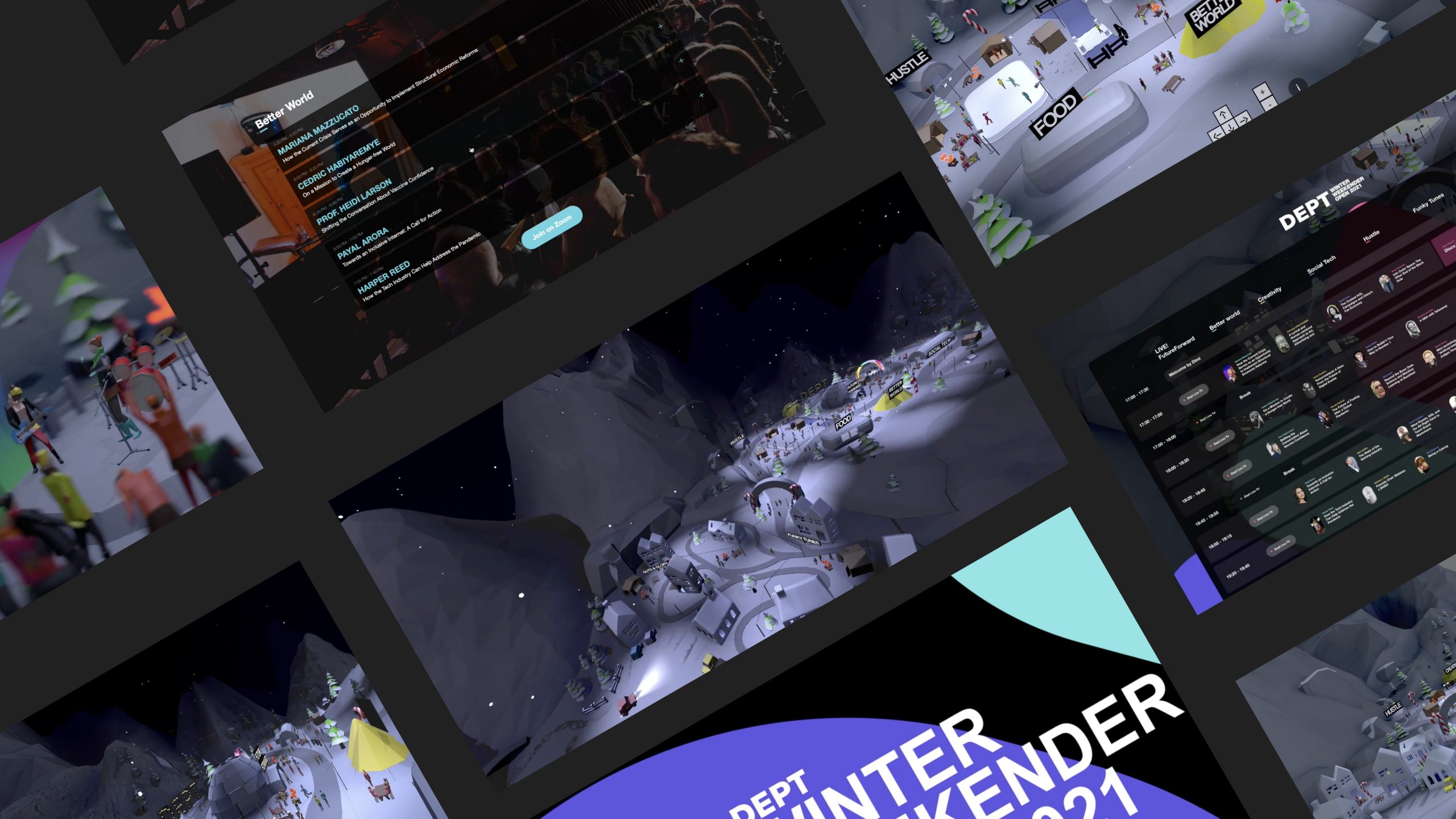
The process behind creating a next-level digital event
Simply transferring all the elements of the original festival to a virtual platform would have led to a clumsy, unsatisfying result. Therefore, reimagination was the key. To kick off the process, we started by conceptualising our vision, the platform and the architecture of the event. The concept was crucial as this became our red thread both visually but also across our communication which we could always refer back to.
With a clear theme and concept, we quickly began to build our 3D map using React Three Fiber, a front-end tool specifically engineered to manage and bring 3D experiences to life. This, in turn, connected to Zoom, Slack and Vimeo. Our designers had the first version up and running in just a couple of weeks.
While our developers and designers continued to refine and test the platform, our communication team arranged 50 speakers in addition to 15 stage hosts while also locking in extra goodies and entertainment we had up our sleeve.
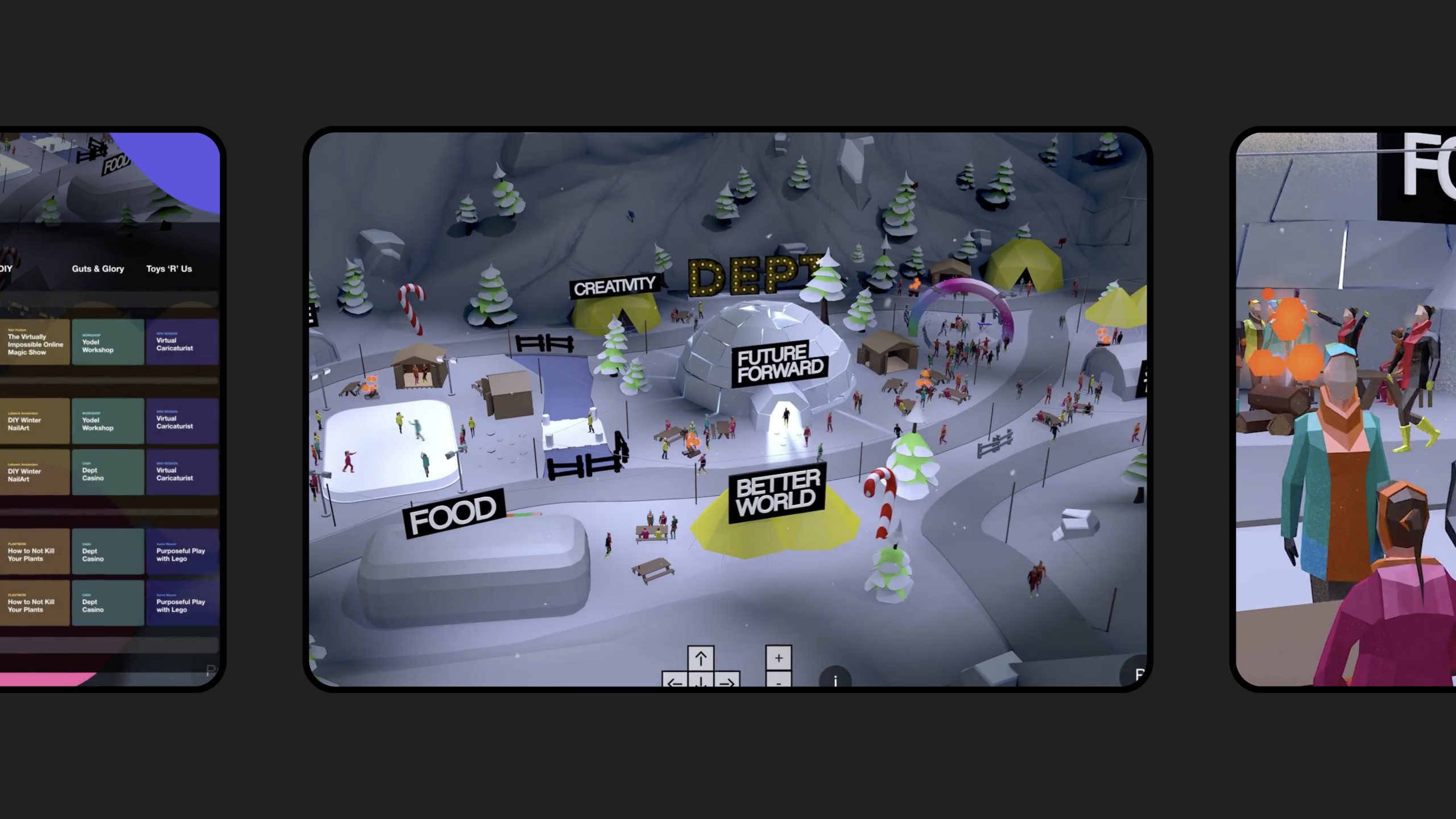
Enticing and hyping up Depsters for what’s to come
Apart from designing the experience, we wanted to excite Depsters with what was to come. So we crafted an internal social campaign which included daily hints from our zebra mascot and teaser videos. These social drops excited Depsters worldwide and conveyed that this was not an ordinary Zoom event.


A seamless, online-offline event experience
In two months time, we designed and built a custom made a custom 3D festival map which one could easily explore and that was protected by single sign-on. The design and layout digitally recreated the festival site from the previous four years, squeezing in 15 stages and 35+ short and snappy presentations into a 3-hour event, and included some industry heroes like Stefan Sagmeister and Gmunk. A personal welcome movie by CEO Dimi Albers and DEPT® stage hosts made everyone feel welcome. With the help of Slack and ‘social reporters’, people knew what was going on all the virtual stages, creating a healthy amount of event FOMO, before and after the event.
Presentation topics ranged from diversity and inclusion to data intelligence, the future of voice, and coding for a 3D world. The fun was provided by virtual meditation, magicians, karaoke and DJ sets. ‘Easter eggs’ were hidden around the virtual map, leading people to things like the ten most famous internet cat movies, and a crazy Zoom background contest. The virtual Photo Booth generated a live photo wall, and in all thirteen countries, Depsters could have food delivered to their doorsteps via Ubereats and JustEat Takeaway after a visit to the digital food truck.
Looking forward
Because of COVID-19, virtualisation has become the new norm and this will shape the future by creating new hybrid events which combine both physical and digital elements. And it doesn’t stop with virtual events, imagine virtual product launches, remote assistance and digital campuses. Thinking bigger, one could picture entire online environments that enable organisations to exchange knowledge or try out products and services in an accessible and personal manner.
For organisations that want to explore possibilities for their virtual event and beyond, we offer services such as concepting, designing and building a virtual 3D world, supporting your brand deploy the necessary technology and security to host a large scale event in addition to helping with the production side of things. Because, in the end, life is too short to host boring events.
Questions?
Executive Creative Director
Max Pinas
Marketplaces, voice search and Artificial Intelligence (AI) have been the three biggest e-commerce advertising trends of 2019. These trends affect marketers jobs, marketing strategies and company business models. So how can you distinguish your marketing, sales and aftersales processes when everyone is using the same advertising platforms and automated systems?
The two biggest marketplaces are Google and Amazon, who are continuously competing against each other. Amazon is the third biggest advertising platform in North American and Google is bolstering its marketplace features. Alongside this, voice search continues to grow which results in a new way of reaching consumers. Thus, both Google and Amazon are competing to become the default virtual assistant in people’s homes. Lastly, AI has been on the rise for some time now and continues to change both the marketing landscape and how the two aforementioned platforms operate.
Trend 1 – the evolution of Google and Amazon
Google Shopping is a product comparison platform where consumers are sent to third parties websites for their actual purchase. Right now, every click on an ad costs the advertisers. However, Google is testing a new feature called Google Shopping Action, which would allow customers to buy products directly from its site without being redirected. Each purchase would give a sales commission to Google allowing it to increase its sales via e-commerce. This means it becomes a direct competitor of other marketplaces such as Amazon.
On the other hand, you have Amazon – which has an established marketplace concept – but is also emerging as an advertising platform. Under the new name Advertising Amazon, the company now offers marketing opportunities which include: product display, sponsored products, sponsored brands and its own DSP allows you to buy programmatic video and display ads. Along with new features like video in search ads and remarketing options, Amazon covers the entire customer journey by becoming a one-stop-shop for both vendors and sellers. You don’t even have to sell your products on Amazon to advertise via the website.
Shifting customer loyalty
By rolling out Google Shopping Action, Google is appropriating a large part of the customer journey. If a consumer buys directly via the platform without visiting a third-party website, they will not interact with the brand. This means the individual misses all branding initiatives and is less likely to become a returning customer. Customer loyalty will gradually shift from brand names to Google, something which sellers on Amazon had already taken into account.
Trend 2 – voice, the new way of searching
Shifting brand loyalty can also be seen with the rise of virtual assistants and voice search. Let’s say you voice search for a pair of pants, you don’t want to hear all the options available, as listening to that could take the entire day. So, the voice assistant will go through the search results and offer the best recommendations based on your past behaviour. This creates a new challenge for companies: their webshops now also need to be voice search friendly or else they will miss out on numerous sales opportunities.
A new playing field
Voice is predicted to become a new advertising channel which could revolutionise how we market to consumers. So, how can you stay relevant in an increasingly audio-focused world? That will mainly depend on which virtual assistant comes to dominate the market. And that fight has only just begun, so it is too early to draw any conclusions. However, a significant difference that could determine this battle between Amazon and Google is the approach: Amazon mainly wants to sell items whilst Google is more focused on providing people with answers.
Trend 3 – AI as an advertising solution
Tech companies started implementing AI in the form of machine learning years ago. Examples of this are ad suggestions on Google Ads Recommendations page or Amazon’s Product Targeted sampling program which allows customers to be selected, via machine learning, for a product sample. Bigger companies are making their solutions available to the public resulting in work being automated and taken out of marketeer’s hands. One example of this is Black Friday 2017, Google advised companies to change their bids manually due to the expected spike. But in 2018, this was no longer necessary as the process was automated. Even writing and optimising text advert can now be done automatically. And because AI and automation continue to grow and their processes improved, the work of the marketers is also evolving.
Embracing AI
Starting from scratch can be daunting, thus brands can implement easily accessible solutions from Google, Amazon or Microsoft to embed AI and machine learning into their company. Features such as speech to text options, translating web pages automatically or classifying images are easy to implement and easily improve your service. Additionally, AI and machine learning solutions can help you collect and organise large amounts of data such as meter readings or online surveys. But also it can help show patterns in your data. You could, for example, see which customers return products on a frequent basis and exclude them from your target audience. Conversely, you can also predict which visitors could lead to more sales and send them more personalised offers. Thus, when implementing AI, keep in mind your audience preference but also your internal operations and how it could help improve those.
Shifts within the industry
Traditionally, marketers were held accountable for the results of their campaigns. This created a feeling of direct control. However, now that more and more tasks are being automated, this control is being handed over to AI-driven tools. The role of marketers is shifting from executor to coordinator. This change is also making it more difficult for employees to stand out, creating a more competitive industry and changing the job market, when most of the focus lies in optimisation instead of creation. For example, much of the work of an SEA marketeer is being automated. Thus, one can wonder if this position will still exist in a couple of years. At the same time, companies are also creating digital teams to help them transition into this digital era whilst encouraging all other departments to embrace newer technologies.
The impact on advertising
These three trends force advertisers to think carefully about the future. Advertising platforms are evolving which is changing the role of marketers. The e-commerce landscape is a crowded one, making it quite difficult for sales people of commodity products with little or no product knowledge or other distinction. If you are not the cheapest and you have no other USPs, the question is: what right do you have to exist online?
A good example of this is the online battery market. Batteries were increasingly bought via Amazon, who, in 2009, launched its own cheaper battery brand under the name AmazonBasics. More products soon followed suit. The company now has over 100 own private labels and a 90 per cent market share in five different product groups. Because Amazon, and later Google, fully understands all sales data, they can see exactly what is selling well vs not. So how can you respond on that as a brand or manufacturer?
Distinguish yourself with branded commerce
The above three trends influence all aspects of your business and change how you sell your brand and yourself. However, just following these guidelines is not enough to make you stand out. In this digital age, you need to be more distinct and memorable than your competitors. This is where branded commerce comes in and ties all aspects of your story together. For many companies, branding and e-commerce are separate: a homepage with a great brand story which leads to a bland table of products and prices which add little value. But, by combining branding with e-commerce you will improve your customer experience and you will build brand preference. For example, enrich your category and product pages with a handy wizard, short videos of influencers or the story of a designer. Because to keep customers interested in your brand and to attract new clients you need a strong but unique story which you broadcast loudly to the world. This combination of branding and e-commerce is called branded commerce and represents a shift for advertisers from transactional to relational thinking.
Stay relevant
Marketplaces, voice search and AI are much bigger and affect all aspects of a company. These trends not only have a huge impact on how companies sell online, but also on how consumers behave. They are impacting the job market by creating and eliminating careers and changing responsibilities. They are positively impacting e-commerce by making the process of marketing, sales and aftersales smoother, more efficient and more personalised. Thus, these new platforms and technologies are not end-all-be-all solutions but combined with branded commerce they can elevate your brand allowing you to stand out of the crowd.
More Insights?
View all InsightsQuestions?
Head of Paid Media
Bas de Knegt
Every brand, regardless of industry, is chasing similar goals: profitable growth, effective advertising, and data-driven decisions. For years, third-party data has been the key to achieving these goals.
But what happens in a cookieless world where third-party data is gone?
Data disruption has made retail media networks (and their gold mine of first-party data) incredibly attractive. Marketplaces like Amazon possess over a decade of data on user segments and shopping behaviors, which can benefit any brand looking for growth.
But knowing the value of retail media is only the first step. For non-endemic brands without retail experience, you need a thoughtful approach that starts with Amazon.
What is non-endemic advertising?
Non-endemic advertising occurs when brands leverage retailers to promote products or services that can’t be purchased in a retail environment. For example, an insurance company advertising its services on Amazon would be considered non-endemic. Other industry examples include financial services, travel, automotive, restaurants, and education.
A non-endemic ad can reach new customers at every stage of the buying journey and across the entire retailer ecosystem. Brands can use this “third-party” data to understand demographics, shopping behavior, and consumer trends.
This translates to:
- Increased brand awareness
- Diversification of marketing channels
- Targeting new market segments
- Enhanced brand association
- Engagement and conversions
Non-endemic brands should start with Amazon
As the leader in retail media, Amazon is a safe bet for non-endemic advertisers. Its vast audience reach encompasses hundreds of millions of active users browsing various product categories, creating many opportunities for targeting non-endemic audiences.
With Amazon’s purchase intent data, you can gain valuable insights into consumer behavior. This allows you to target your ads to users actively searching for related products or displaying interest in similar categories. For example, a brand could promote travel insurance to users who purchase new roller luggage.
The contextual relevance of non-endemic ads on Amazon, appearing within a user’s shopping journey, helps their effectiveness. You can influence purchase decisions and generate leads through offers like test drives, attending an event, a landing page visit, or booking an appointment. Amazon’s performance-based pricing model ensures you only pay for measurable results, such as clicks or sales generated.
Retail networks beyond Amazon
As powerful as Amazon is, it is not the only choice. There are over 200 retail media networks (RMNs) worldwide.
Non-endemic brands will want to stick with large RMNs since smaller ones are limited to brands that sell physical products (endemic). The largest RMNs also typically have the most robust data.
That said, new retailers jump on the retail media train and open their data for advertising daily, so it’s essential to understand the process behind selecting the right partners.
First, let’s return to the fundamental value that an RMN offers to an advertiser—its first-party data, which enables informed targeting.
As a non-endemic advertiser, you should seek to work with networks offering a potential audience relevant to your objectives. Many retailers specialize in categories like fashion or household appliances, so it’s simply a matter of filtering which ones align.
Most retailers will be specialists (Wayfair) or generalists (Walmart.) Due to their broad audience, generalist retail media networks are more likely to offer value. Specialist networks will either be extremely relevant to your objectives or not.
Also, consider which network offers the capability required to meet your goal. Perhaps the most important element here is the potential reach. Generalist networks typically win here too. They probably have a niche audience your brand can reach.
This process should be repeated for each country you want to advertise in. Each region has a unique retail media landscape, and the right network will probably differ from country to country.
What to expect from non-endemic retail media in the next few years?
In the coming years, expect more complexity:
- The number of retail media networks will continue to grow, increasing the existing challenges around planning, managing, and measuring media.
- Innovations such as Digital-Out-Of-Home will become a part of the media mix as retailers open up new inventory types alongside their online offerings.
- The increasing prioritization of non-endemic advertisers will change the competitive dynamics of programmatic advertising.
However, there is a degree of conformity within all of that complexity. All RMNs offer the same core advantage, first-party data-driven audiences based on actual purchases rather than vague interest. For the non-endemic advertiser, this will remain the most important consideration in selecting which networks to utilize.
Beginning your non-endemic retail media journey requires a blend of advertising strategy, experience with RMN technology, and data analysis. We recommend working with a partner with retail media experience to succeed in this new arena.
As an Amazon partner and working with other RMNs, our retail media team can simplify the process.
Questions?
Team Lead Retail Media & Amazon Partner Manager



